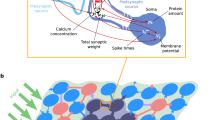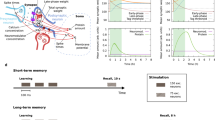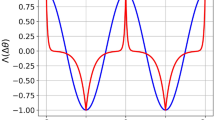Abstract
State-dependent learning is a phenomenon in which the retrieval of newly acquired information is possible only if the subject is in the same sensory context and physiological state as during the encoding phase1. In spite of extensive behavioural and pharmacological characterization2, no cellular counterpart of this phenomenon has been reported. Here we describe a neuronal analogue of state-dependent learning in which cortical neurons show an acetylcholine-dependent expression of an acetylcholine-induced functional plasticity. This was demonstrated on neurons of rat somatosensory ‘barrel’ cortex, whose tunings to the temporal frequency of whisker deflections were modified by cellular conditioning. Pairing whisker stimulation with acetylcholine applied iontophoretically yielded selective lasting modification of responses, the expression of which depended on the presence of exogenous acetylcholine. Administration of acetylcholine during testing revealed frequency-specific changes in response that were not expressed when tested without acetylcholine or when the muscarinic antagonist, atropine, was applied concomitantly. Our results suggest that both acquisition and recall can be controlled by the cortical release of acetylcholine.
This is a preview of subscription content, access via your institution
Access options
Subscribe to this journal
Receive 51 print issues and online access
$199.00 per year
only $3.90 per issue
Buy this article
- Purchase on Springer Link
- Instant access to full article PDF
Prices may be subject to local taxes which are calculated during checkout




Similar content being viewed by others
References
Izquierdo, I. in Neurobiology of Learning and Memory (eds Lynch, G., McGaugh, J. L. & Weinberger, N. M.) 333–358 (Guilford, New York, 1984).
Gordon, W. C. & Klein, R. L. in Animal Learning and Cognition (ed. Mackintosh, N. J.) 255–279 (Academic, San Diego, 1994).
Mesulam, M. M., Mufson, E. J., Wainer, B. H. & Levey, A. I. Central cholinergic pathways in the rat: an overview based on an alternative nomenclature (Ch1–Ch6). Neuroscience 10, 1185–1201 (1983).
Richardson, R. T. & DeLong, M. R. A reappraisal of the functions of the nucleus basalis of Meynert. Trends Neurosci. 11, 264–267 ( 1988).
Singer, W. in Brain Organization and Memory: Cells, Systems, and Circuits (eds McGaugh, J. L., Weinberger, N. M. & Lynch, G.) 211–233 (Oxford Univ. Press, New York, 1990).
Ahissar, E. & Ahissar, M. Plasticity in auditory cortical circuitry. Curr. Opin. Neurobiol. 4, 580– 587 (1994).
Weinberger, N. M. Dynamic regulation of receptive fields and maps in the adult sensory cortex. Annu. Rev. Neurosci. 18, 129– 158 (1995).
Dykes, R. Mechanisms controlling neuronal plasticity in somatosensory cortex. Can. J. Physiol. Pharmacol. 75, 535–545 (1997).
Edeline, J. M. Learning-induced physiological plasticity in the thalamo-cortical sensory systems: a critical evaluation of receptive field plasticity, map changes and their potential mechanisms. Prog. Neurobiol. 57 , 165–224 (1999).
Metherate, R. & Weinberger, N. M. Acetylcholine produces stimulus-specific receptive field alterations in cat auditory cortex. Brain Res. 480, 372–377 ( 1989).
Edeline, J. -M., Hars, B., Maho, C. & Hennevin, E. Transient and prolonged facilitation of tone-evoked responses induced by basal forebrain stimulations in the rat auditory cortex. Exp. Brain Res. 97, 373–386 (1994).
Kilgard, M. P. & Merzenich, M. M. Cortical map reorganization enabled by nucleus basalis activity. Science 279, 1714–1718 (1998).
Kilgard, M. P. & Merzenich, M. M. Plasticity of temporal information processing in the primary auditory cortex. Nature Neurosci. 8, 727–731 (1998).
Rasmusson, D. D. & Dykes, R. W. Long-term enhancement of evoked potentials in cat somatosensory cortex produced by co-activation of the basal forebrain and cutaneous receptors. Exp. Brain Res. 70, 276–286 ( 1988).
Jacobs, S. E. & Juliano, S. L. The impact of basal forebrain lesions on the ability of rats to perform a sensory discrimination task involving barrel cortex. J. Neurosci. 15, 1099– 1109 (1995).
Baskerville, K. A., Schweitzer, J. B. & Herron, P. Effects of cholinergic depletion on experience-dependent plasticity in the cortex of the rat. Neurosci. 80, 1159–1169 (1997).
Maalouf, M., Miasnikov, A. A. & Dykes, R. W. Blockade of cholinergic receptors in rat barrel cortex prevents long-term changes in the evoked potential during sensory preconditioning. J. Neurophysiol. 80, 529– 545 (1998).
Sachdev, R. N., Lu, S. M., Wiley, R. G. & Ebner, F. F. Role of the basal forebrain cholinergic projection in somatosensory cortical plasticity. J. Neurophysiol. 79, 3216–3228 (1998).
Woolsey, T. A. & Van der Loos, H. The structural organization of layer IV in the somatosensory region (SI) of mouse cerebral cortex. The description of a cortical field composed of discrete cytoarchitectonic units. Brain Res. 17, 205–242 (1970).
Carvel, G. E. & Simons, D. J. Biometric analyses of vibrissal tactile discrimination in the rat. J. Neurosci. 10, 2638–2648 (1990).
Ahissar, E., Haidarliu, S. & Zacksenhouse, M. Decoding temporally encoded sensory input by cortical oscillations and thalamic phase comparators. Proc. Natl Acad. Sci. USA 94, 11633–11638 ( 1997).
Webster, H. H. et al. Long-term enhancement of evoked potentials in racoon somatosensory cortex following co-activation of the nucleus basalis of Meynert complex and cutaneous receptors. Brain Res. 545, 292 –296 (1991).
Howard, M. A. & Simons, D. J. Physiologic effects of nucleus basalis magnocellularis stimulation on rat barrel cortex neurons. Exp. Brain Res. 102, 21–33 (1994).
Ahissar, E., Haidarliu, S. & Shulz, D. E. Possible involvement of neuromodulatory systems in cortical Hebbian-like plasticity. J. Physiol. (Paris) 90, 353–360 (1996).
Delacour, J., Houcine, O. & Costa, J. C. Evidence for a cholinergic mechanism of “learned” changes in the responses of barrel field neurons of the awake and undrugged rat. Neuroscience 34, 1– 8 (1990).
Shulz, D. E., Cohen, S., Haidarliu, S. & Ahissar, E. Differential effects of acetylcholine on neuronal activity and interactions in the auditory cortex of the guinea-pig. Eur. J. Neurosci. 9, 396–409 (1997).
Haidarliu, S. & Ahissar, E. Spatial organization of facial vibrissae and cortical barrels in the guinea pig and golden hamster. J. Comp. Neurol. 385, 515–527 ( 1997).
Haidarliu, S. An anatomically adapted, injury-free headholder for guinea pigs. Physiol. Behav. 60, 111–114 (1996).
Haidarliu, S., Shulz, D. E. & Ahissar, E. A multi-electrode array for combined microiontophoresis and multiple single-unit recordings. J. Neurosci. Meth. 56, 125–131 (1995).
Acknowledgements
We thank Y. Dudai, Y. Frégnac, H. Markram, P. Salin and M. Segal for helpful comments, and A. Bagady for help with statistical analysis. V.E. and D.E.S. were supported by the French Embassy in Israel during their visits to the laboratory of E.A. where the experiments were done. This work was supported by PICS CNRS, Ministère des Affaires Etrangères Français, AFIRST, HFSP, US-Israel Binational Science Foundation, Israel and the MINERVA Foundation, Germany.
Author information
Authors and Affiliations
Corresponding author
Supplementary information
41586_2000_BF35000586_MOESM1_ESM.doc
Figure A. Reversal of a response potentiation induced by a first conditioning at 8 Hz by a second pairing at 11 Hz. (DOC 50 kb)
Rights and permissions
About this article
Cite this article
Shulz, D., Sosnik, R., Ego, V. et al. A neuronal analogue of state-dependent learning. Nature 403, 549–553 (2000). https://doi.org/10.1038/35000586
Received:
Accepted:
Issue Date:
DOI: https://doi.org/10.1038/35000586
This article is cited by
-
Norepinephrine potentiates and serotonin depresses visual cortical responses by transforming eligibility traces
Nature Communications (2022)
-
Mammillary body regulates state-dependent fear by alternating cortical oscillations
Scientific Reports (2018)
-
Coordinated forms of noradrenergic plasticity in the locus coeruleus and primary auditory cortex
Nature Neuroscience (2015)
-
Вeta1-Adrenoreceptors of the CA1 Area Mediate Morphine-Modified State-Dependent Memory in Rats
Neurophysiology (2013)
-
Activity recall in a visual cortical ensemble
Nature Neuroscience (2012)
Comments
By submitting a comment you agree to abide by our Terms and Community Guidelines. If you find something abusive or that does not comply with our terms or guidelines please flag it as inappropriate.



